How To Fix A Broken Apartment Lease
Q
How long does a landlord have to fix something?
A
A landlord typically has 3-7 days to fix critical repairs, and 30 days to fix non-critical repairs. However, the exact numbers vary depending on your specific state's landlord-tenant law.
Waiting on your landlord to fix repairs can be a frustrating situation, and you may feel powerless to do anything about it. For this reason, it's important to understand the expected repair timelines that landlords should be following, what tenants can do if landlords fail to make repairs, and the different responsibilities of each party. It's also important to note that exact specifications for fixing repairs vary significantly from state-to-state, so you'll need to do your research on landlord-tenant law.
Take a look at our resource guides for landlord-tenant law in each state to help determine your locality's repair timeline, along with the general repair guidelines below:
- What is the Warranty of Habitability?
- Critical vs Non-Critical Repairs
- Normal Wear and Tear Vs. Tenant-Caused Repairs
- Steps Tenants Can Take if Repairs Aren't Made
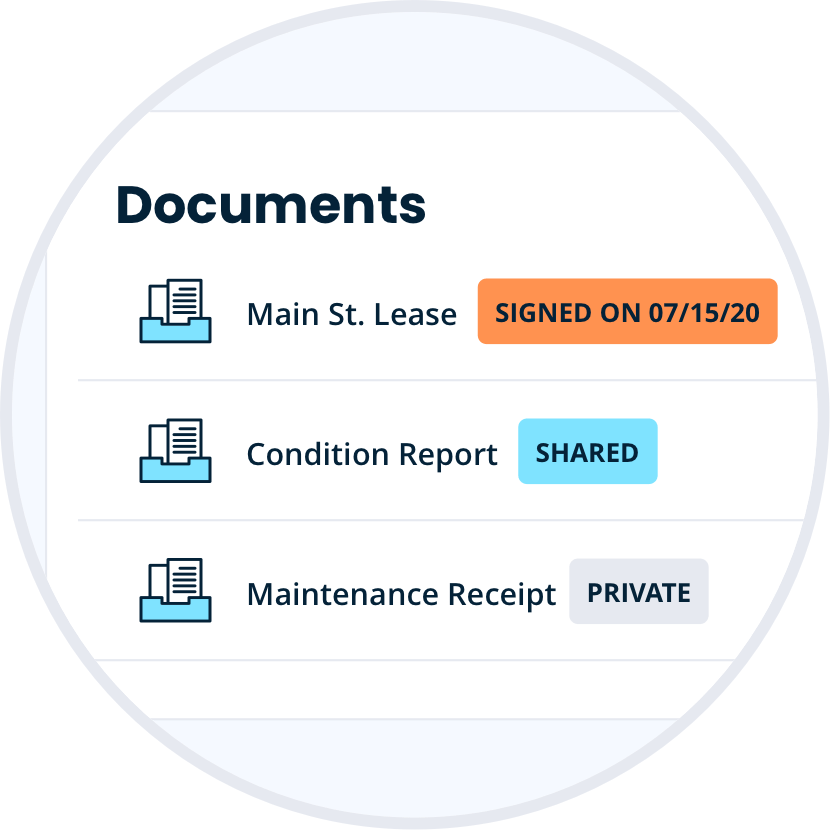
Need More Landlord Forms?
Download our essential landlord forms pack for just $99 in your TurboTenant account. From welcome letters to property inspection forms, we have you covered.
What is the Warranty of Habitability?
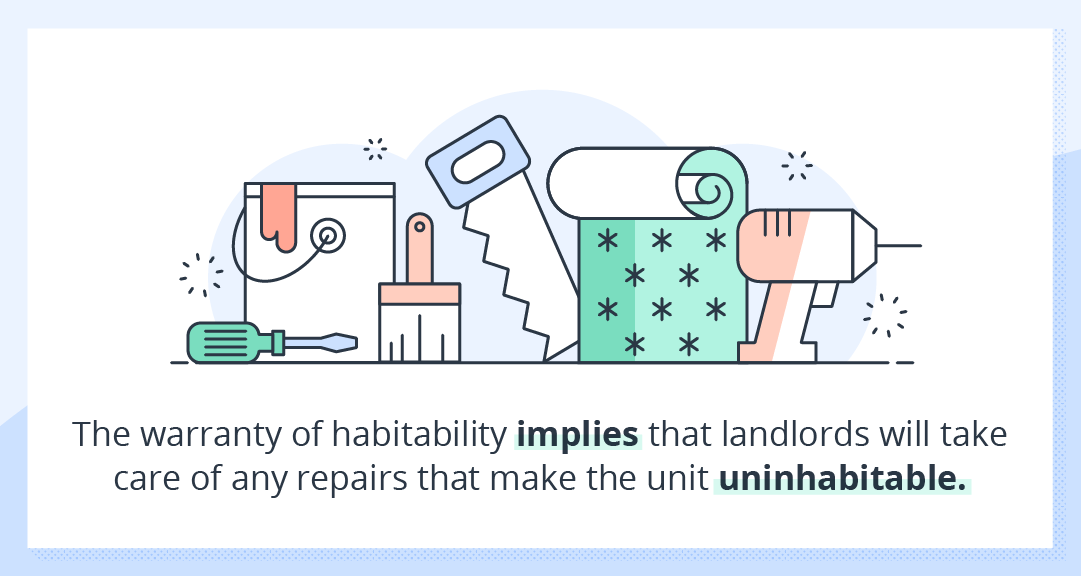
The warranty of habitability is similar to the covenant of quiet enjoyment in that it is animplied legal provision in a lease. This means that although the lease may not detail each and every repair specifically, it is assumed in a legal sense that landlords will and must make repairs to ensure the unit remains habitable. In order to determine if a unit is habitable or inhabitable, it's important to understand the differences between critical and non-critical repairs. We've included several examples of each below, along with their general repair timelines.
How Long Does a Landlord Have to Fix Repairs?
Critical repairs violate the warranty of habitability by making the unit unlivable. Therefore landlords must fix these repairs in a timely manner and aretypically given three to seven days to resolve the issue. If a repair is non-critical and therefore does not violate the warranty of habitability, landlords typicallyhave up to 30 days to resolve the issue.
Again, it's very important to understand that each state has different laws that specifically apply to repair timelines. Landlord-tenant law is not necessarily the same in Florida as it is in Texas, or in any other U.S. state.
How Long Does a Landlord Have to Fix Critical Repairs?
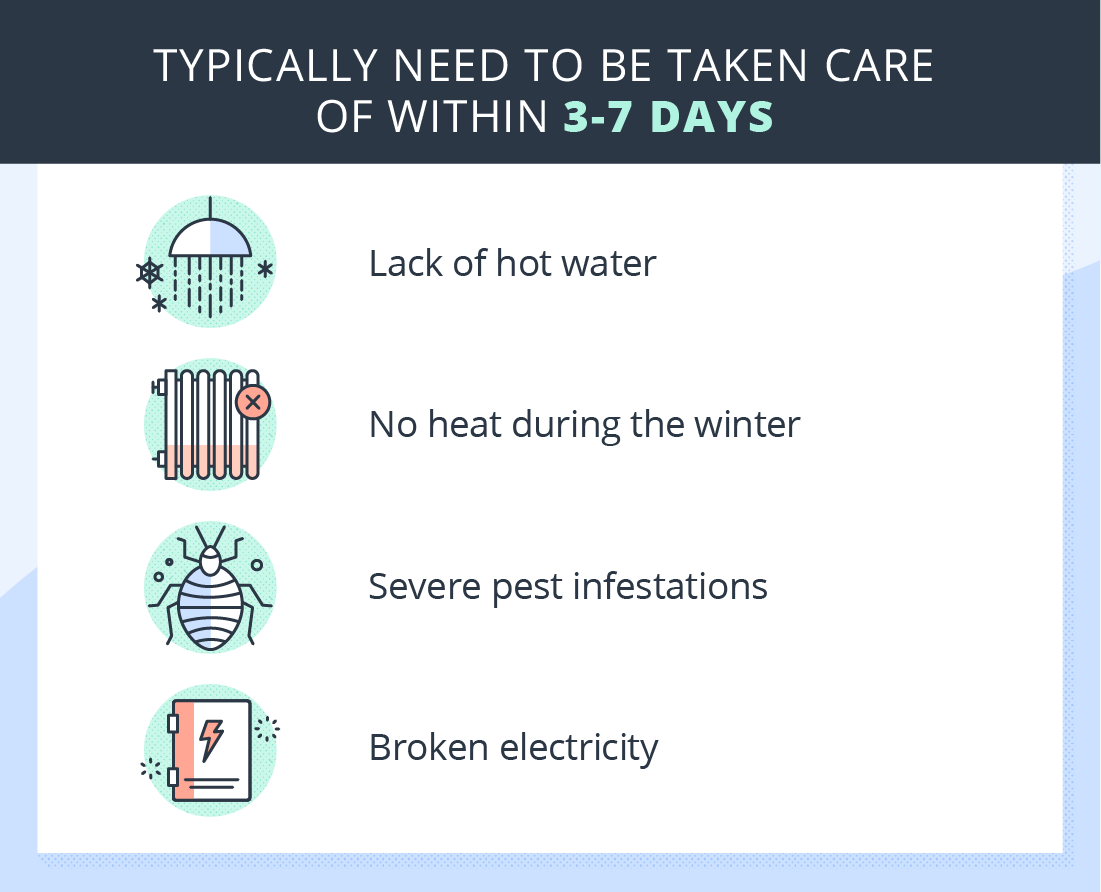
As previously mentioned, critical repairs are major issues that would make living in the unit impossible, very difficult, or dangerous. These include problems such as:
- Lack of hot water
- Lack of potable (drinkable) water
- Lack of heat during the winter
- Lack of electricity
- Lack of functioning plumbing and waste removal
- A broken refrigerator (if originally supplied by the landlord)
- Broken or absent smoke and carbon monoxide detectors
- Severe pest infestations such as cockroaches, mice, or bedbugs
How Long Does a Landlord Have to Fix Non-Critical Repairs?
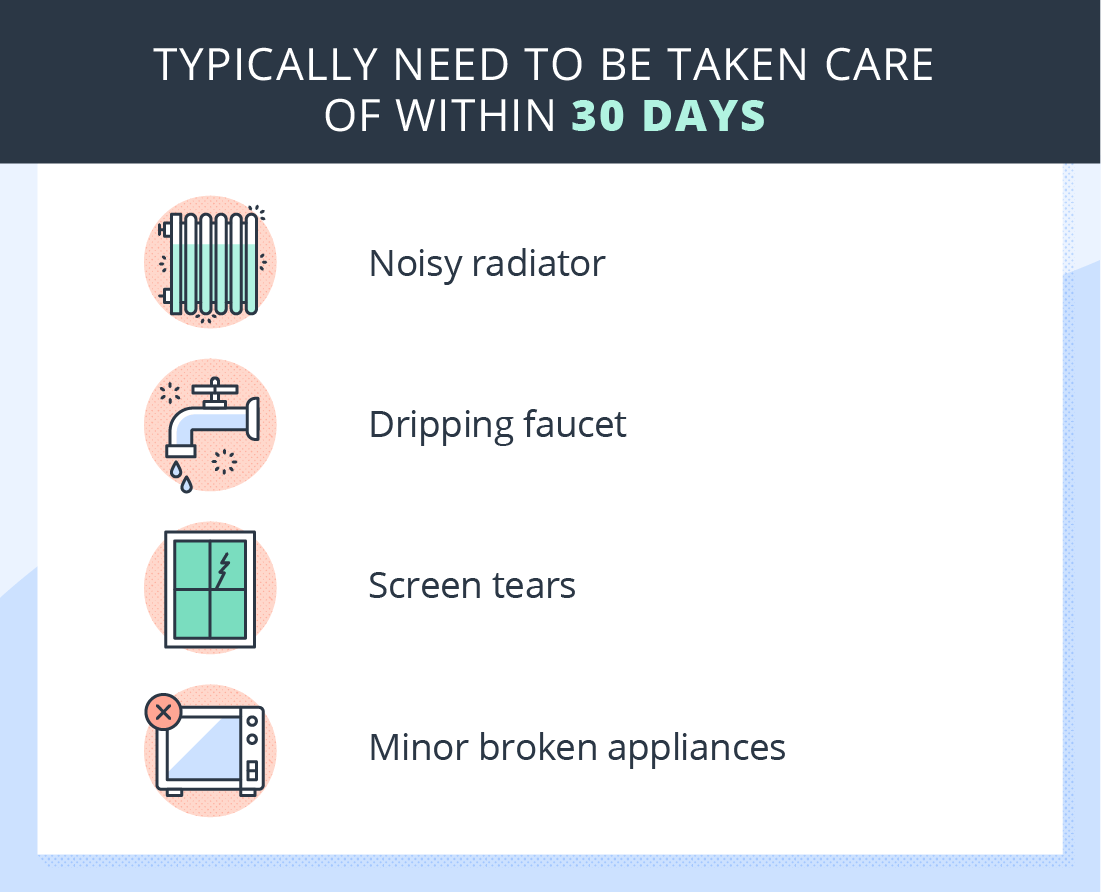
These maintenance issues might be frustrating but they do not make living in the unit impossible or unsafe, so landlords have a longer time to resolve them. These types of problems include:
- Squeaky floors
- Noisy radiators
- Screen tears
- Broken ceiling fan
- Dripping faucet
- Unhinged cabinet doors
- Minor broken appliances like dishwashers and microwaves
Normal Wear and Tear vs Tenant-Caused Repairs
Repairs can get trickier when it's not clear who's responsible for damaging the item in the first place. Here are some examples that can help clear up these types of situations.
Normal Wear and Tear
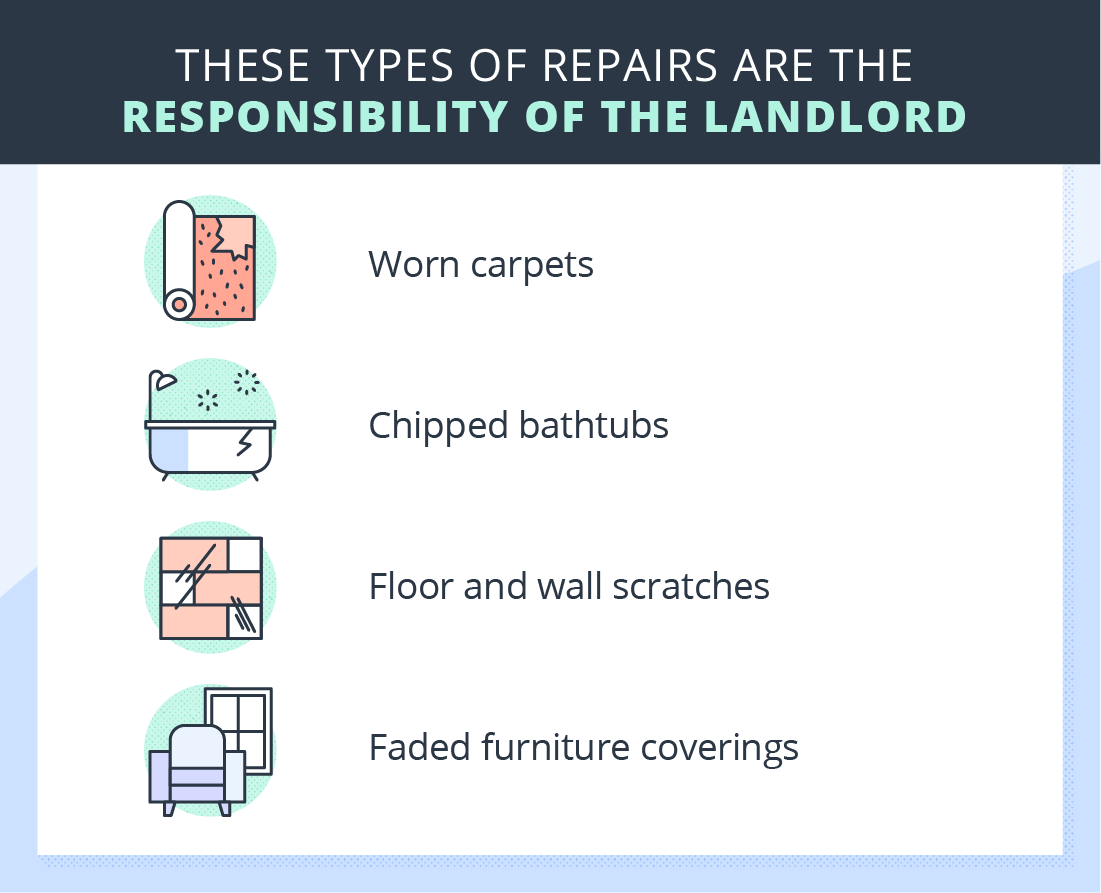
An important distinction for both landlords and tenants to understand is the concept of normal wear and tear. Apartment furniture and structures will naturally wear out with use over time, and these types of issues are the responsibility of the property owner or landlord to fix. These are most often non-critical repairs.
Examples of normal wear and tear landlords can expect to see include:
- Worn out carpets
- Rusty faucets
- Chipped tubs
- Paint scratches
- Floor and wall scratches
- Faded curtains or furniture coverings due to sun exposure
Tenant-Caused Repairs
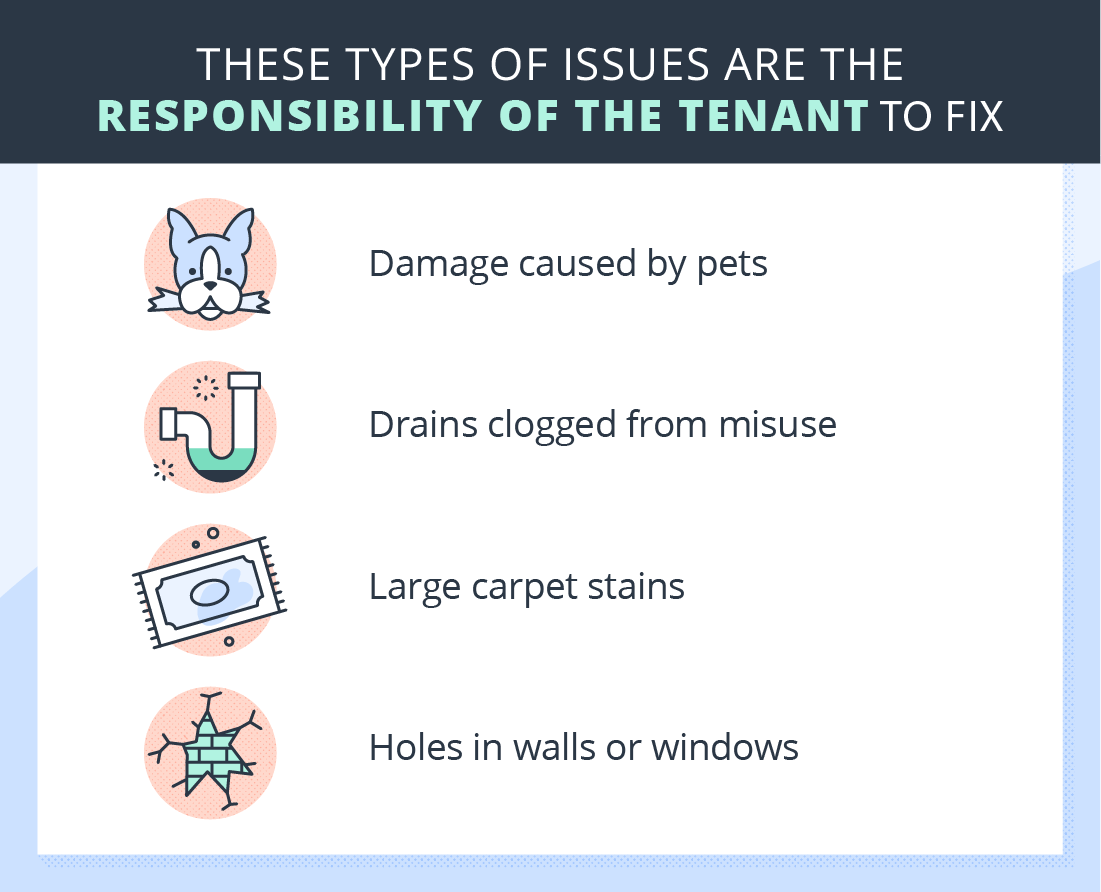
Though tenants are not responsible for normal wear and tear damages, they will need to repair and pay for issues that they cause. Whether it's neglecting an on-going issue until it becomes critical or actively damaging the unit, below are a handful of examples of tenant-caused repairs. Landlords should be sure to keep records of move-in and move-out inspections in order to track tenant damages vs normal wear and tear. Here are some examples of repairs tenants would be responsible for:
- Large and noticeable carpet stains
- Appliances broken from tenant misuse
- Clogged drains due to neglect or misuse
- Holes in the walls or windows
- Damage caused by pets
In the case that a tenant damages your rental, you will need to write a letter to a tenant for damages when some or all of their security deposit will not be returned. Get aLetter to Tenant for Damages here.
Steps Tenants Can Take If Repairs Are Not Made
If a tenant finds themselves in this unfortunate situation, there are steps they can take to try to force a landlord to abide by the warranty of habitability.
- Withhold Rent – Again, check your state's landlord-tenant laws to make sure this is a legal course of action. In most states, tenants may legally withhold rent until a critical repair is taken care of. A lease is a two-way agreement, in which tenants agree to pay rent in return for a safe and habitable living environment. If one end of the bargain isn't being held up, then the other won't be either.
- Pay for Repairs – In some states, tenants may pay to fix the repairs themselves and then deduct the cost of the repairs from the next monthly lease payment. You'll need to keep clear records to prove to your landlord how much you paid exactly.
- Report Landlord – If things really go downhill, you can report your landlord to a number of state and local housing agencies. This data is available for the public to access, so this action may motivate landlords to make repairs and save their reputations. City officials can also take action against landlords on your behalf once they are reported.
- Move Out – Again, depending on your state you may be able to move out with no warning and break your lease agreement if a landlord continuously fails to make repairs. You can also bring them to court to pay for your moving and repair fees.
If you're considering any of the courses of action above, it's best to consult with a lawyer ahead of time to make sure you are understanding your state's landlord-tenant laws properly.
Why Landlords Should Make Repairs Promptly
Hopefully, things never need to progress to reporting a landlord or bringing the case to court. It is really in landlords' best interests to fix both critical and non-critical repairs promptly, for a number of reasons:
- Maintain a good relationship: Finding a tenant takes a lot of time and money on behalf of the landlord. If you've found a good tenant, make sure you return the favor in kind by treating them respectfully. This will make for much less stress for both of you in the long run.
- Better for the unit: Not only will making repairs quickly keep your tenants happy, but it's the best way to ensure the longevity of your unit as well. It's better to pay $800 now to fix a cranky boiler than to have to shell out $7,000 the next winter when it completely fails due to your negligence.
- Avoid a bad reputation: As discussed earlier, there are a number of government databases that potential tenants have access to. Most savvy tenants know what to look for on these types of reports, and your chances of finding the best tenants go way down if you have a reputation as a neglectful landlord.
We hope these generalized repair terms and definitions help both tenants and landlords understand the requirements expected of both of them when it comes to timelines for critical and non-critical repairs.
DISCLAIMER: TurboTenant, Inc. does not provide legal advice. This material has been prepared for informational purposes only. All users are advised to check all applicable local, state, and federal laws and consult legal counsel should questions arise.
How To Fix A Broken Apartment Lease
Source: https://www.turbotenant.com/blog/how-long-does-a-landlord-have-to-fix-something/
Posted by: thomaswiltoped.blogspot.com

0 Response to "How To Fix A Broken Apartment Lease"
Post a Comment